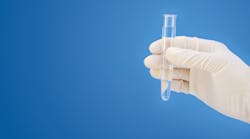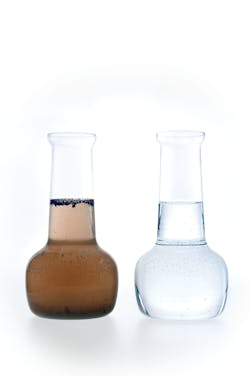One of my favorite things to do on a hot day is to enjoy a nice, refreshing glass of water. We all have our preferences when it comes to water, be it bottled, filtered, or tap. I feel better knowing that my water—whatever the source—has been sterilized or thoroughly cleaned before consuming it. This brings me to my topic: We all have our personal standards for safe drinking water, so why don’t we all ensure that safe water is coming through our dental water lines?
As dental professionals, it is our responsibility to guarantee that our water lines carry water that is safe for our patients. Dental water lines distribute water to high-speed handpieces, air/water syringes, and ultrasonic devices, and studies and past incidents have shown that water line safety should be a priority in our infection control practices.
If our water lines are left untreated, are not properly monitored, or are poorly maintained, then the opportunity for contamination increases, and water lines can introduce the risk of infection to patients. The risk increases during surgical procedures, which can directly introduce pathogens. We, as clinicians, are also at risk due to the inhalation of aerosols during procedures.1
Proof is in the research
Research has shown that the tubing in dental unit water lines—which is narrow in diameter and comprised of rubber, silicone, or plastic—can become colonized with microorganisms. These microorganisms include bacteria, fungi, and protozoa, and they survive in water lines by using a polysaccharide slime protection layer.2 That layer is known as biofilm, which we’re all familiar with, and just as in the mouth, it helps them colonize and multiply.2
We all know the impact that biofilm can have. Biofilm can harbor bacteria in small numbers, but if left untreated, it can create a host environment that resembles a flourishing petri dish. Free-floating microorganisms then contaminate the water, which puts patients at risk for exposure during treatment.
Related reading
Dental unit waterlines: Trickier than you think
Research has demonstrated that within just five days of new water line tubing installation, microbial counts can reach up to 200,000 colony-forming units per milliliter (CFU/mL).2 A colony-forming unit is the minimum number of separable cells in a semisolid agar medium that can catalyze a visible colony of progeny.2 A single CFU can consist of microorganisms in pairs, chains, clusters, or as individual cells, but all are responsible for creating new layers of biofilm.2 Standards have been put in place by the Environmental Protection Agency, American Public Health Association, and American Water Works Association to ensure that heterotrophic bacteria can only be dispensed up to 500 CFU/mL.2 The American Dental Association has also made recommendations, such as the use of sterile water or saline for the irrigation of surgical sites where the bone is exposed.2,3
In 1993, the Centers for Disease Control and Prevention (CDC) recommended that water lines be flushed in the morning before seeing patients to decrease the microbial load.2 However, recommendations with the CDC were updated in 2003. The CDC now advises that flushing lines for at least 20 to 30 seconds between every patient whose saliva and blood is exposed can help prevent introduction of patient material into water lines, but should not be the only method used to prevent biofilm from forming.2
Where does your water come from?
Dental units acquire their water either from city water lines or from independent water units. You might ask, “Is one water source superior to the other?” You might also wonder, “Is self-contained water safer or easier to maintain?” It is easy to assume that if the water is distilled or comes from a treated public water source, then it must be safe. In theory, yes, but after the water has entered our dental water lines, the water sits in those lines. Sometimes it sits overnight. Sometimes over the weekend. And sometimes over a holiday break. Combine this stagnation with low flow rate, lack of antiretraction valves (a feature of some older dental units), and possible contamination via patient material, and you get a perfect situation for a bacterial feast.
Dental water lines, regardless of what delivery system is used, should be appropriately treated for every patient using universal precautions. If dental unit water, whether it is from a municipal or self-contained source, is left unfiltered or untreated, it cannot provide or meet safe drinking water standards.2 And regardless of whether distilled or sterilized water is the main source, if biofilm layers are not controlled in the tubing, then bacterial contamination risks cannot be minimized.2 Removal or inactivation of dental water line biofilm requires the use of chemical germicides, such as cleaners that remove microbial accumulations, and shock treatments.1,2
Safety protocols, maintenance, and monitoring
At this point you might be asking, “How can we keep our water quality safe and biofilm from accumulating?” First, you should immediately establish well-written standard operating guidelines to help dental personnel in performing their infection control duties. The guidelines should clearly state procedures for maintenance and monitoring of dental unit water lines. With this in place, everyone can be trained to know what needs to be done to maintain water quality and safety.
Additional considerations for preventing contamination are as follows: For dental units using separate water reservoirs, purging the dental unit water lines each night and whenever units are out of service to prevent stagnant water from settling in the water lines can help.4 Be alert to signs that may indicate biofilm formation, including musty odor, cloudiness, particulates in the water, and clogging of lines.4
The key steps to help ensure that biofilm does not affect our water lines are simply maintenance and monitoring with regular testing. Water quality can be monitored two different ways: by performing tests using commercial, in-office kits or by using a mail-in kit from a commercial laboratory. Once the results are received, it is up to the dentist to consult with the dental unit manufacturer to determine the best type of maintenance or treatment protocol.2,4
Treatments and how they can help
As mentioned earlier, maintaining water lines requires regular chemical treatments, including water line shock treatment. By doing this, you are allowing the levels of bacteria in the water line to reach an amount that allows for the chemical germicides to work in maintaining or eliminating them. How often a shock is performed depends on the dental practice and its equipment. A variety of maintenance items are available through different manufacturers. It is up to the dentist and team to choose which one they feel will be the easiest for them, to know the frequency of use, and to understand how to use them.
Single-dose tablets can be used on a daily basis to keep microbial levels lower.4 Tablets are used along with a separate shocking treatment.4 Straws and cartridges are used in units that contain independent water reservoirs, and they administer a small amount of antimicrobial agent on a continuous basis to prevent microbial buildup.4 However, with these units, shock treatments help do this as a one-time use and not continuously.
Other methods that can be used include a central water treatment where there is a water line system that dispenses a certain quality of water to all dental units, or using a daily liquid that is put in the water containers.4 Again, it is really up to the dentist and dental staff to determine what method works best for them.
Contaminated water lines are definitely possible, and if left untreated can cause frightening results. But, like many other infection control concerns, water line contamination risks can be managed. Taking the necessary precautions in standard infection control protocols with proper maintenance and regulation helps us to take that extra step to ensure that our patients are taken care of in all aspects.
References
1. Molinari JA. Principles of dental waterline asepsis. Dental Economics website. https://www.dentaleconomics.com/science-tech/article/16389366/principles-of-dental-waterline-asepsis. Published May 1, 2009.
2. Guidelines for infection control in dental health-care settings—2003. Centers for Disease Control and Prevention website. https://www.cdc.gov/mmwr/preview/mmwrhtml/rr5217a1.htm. Published December 19, 2003.
3. Recommended infection-control practices for dentistry, 1993. Centers for Disease Control and Prevention. Morbidity and Mortality Weekly Report. 1993;42(No. RR-8).
4. Elsenpeter R. 4 things you need to know about waterline disinfection. Dental Products Report website. http://www.dentalproductsreport.com/dental/article/4-things-you-need-know-about-waterline-disinfection. Published August 27, 2018.
Additional reading
Dental unit waterlines. US Food and Drug Administration website. https://www.fda.gov/medical-devices/dental-devices/dental-unit-waterlines. Updated September 4, 2018.
Nicole Backes, RDH, RDA, has been working in the dental field since 2008. She started as a registered dental assistant in California and Arizona, and now resides in Texas, where she works as a registered dental hygienist. She graduated magna cum laude from Concorde Career College with an associate’s degree in applied science in dental hygiene, and is still learning to this day as she works on obtaining her bachelor’s degree in dental hygiene








